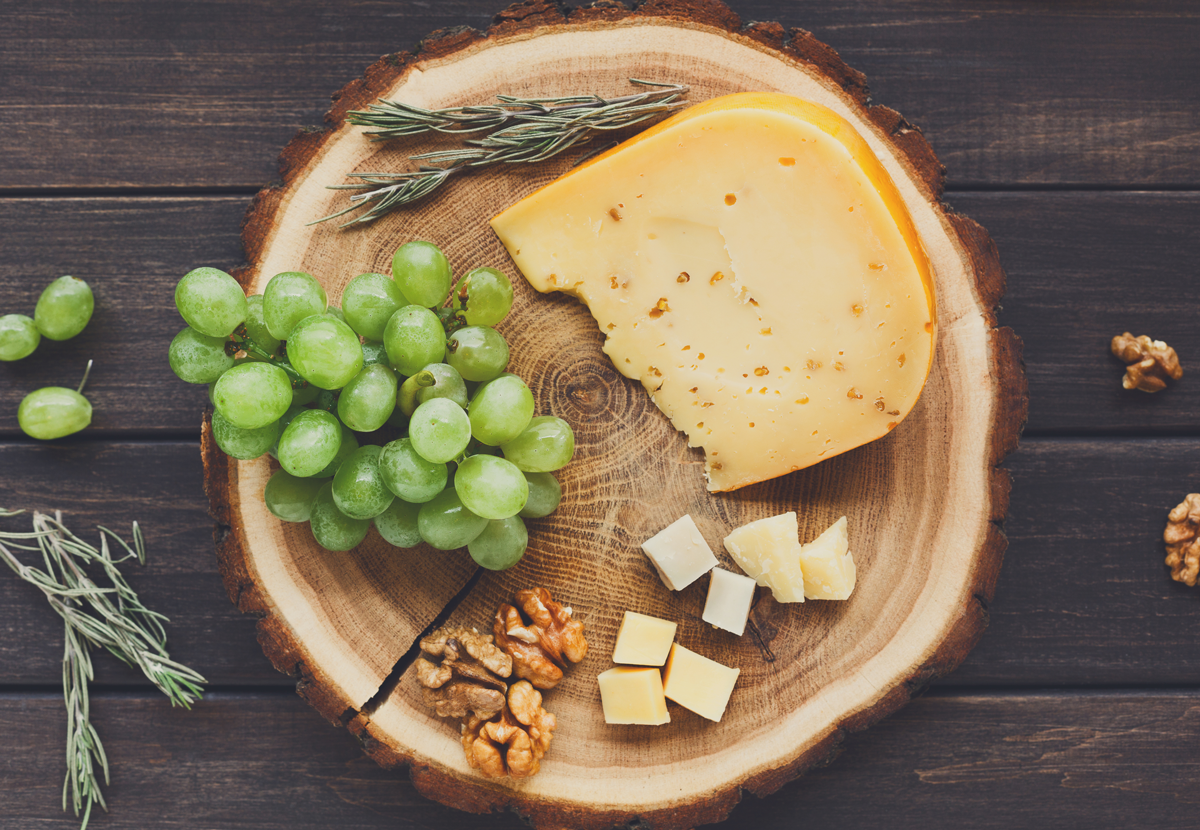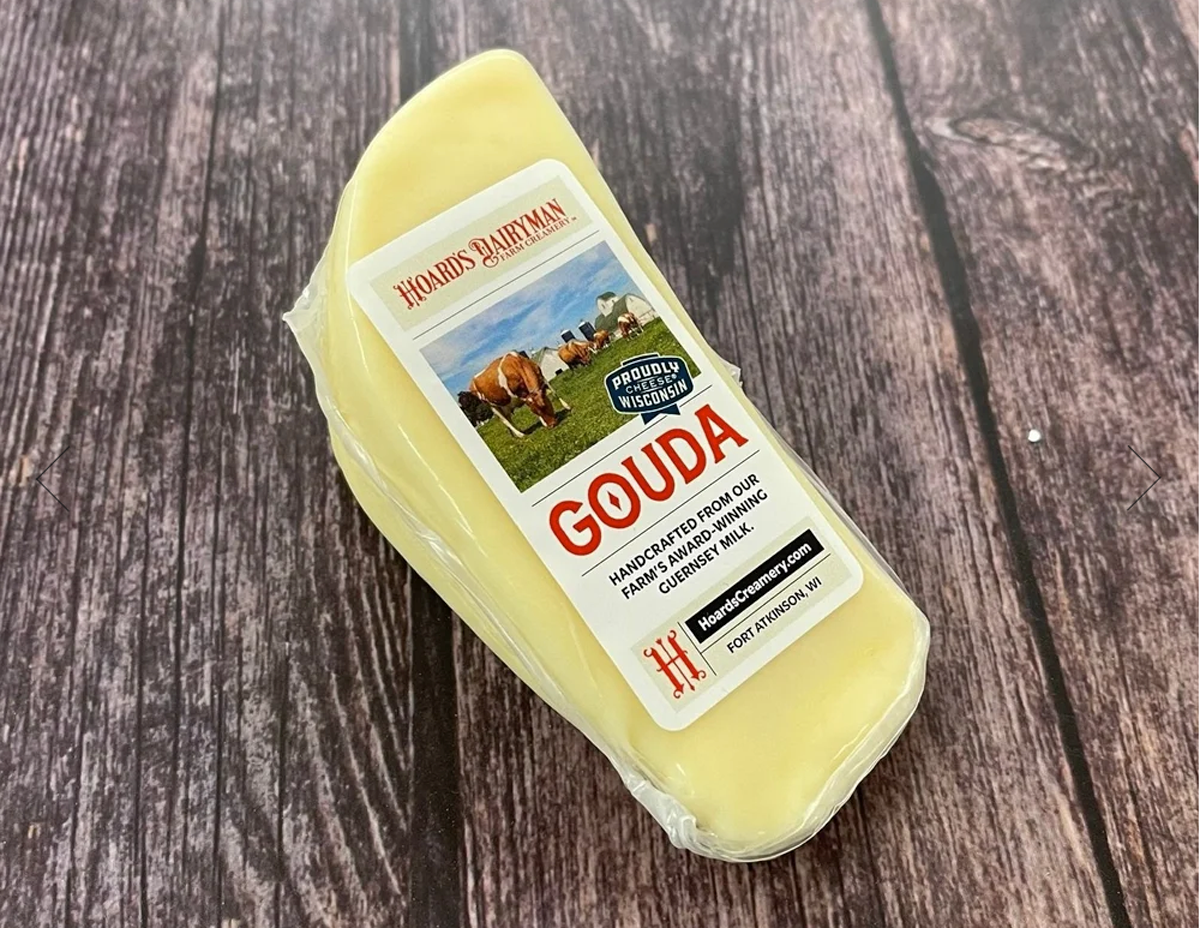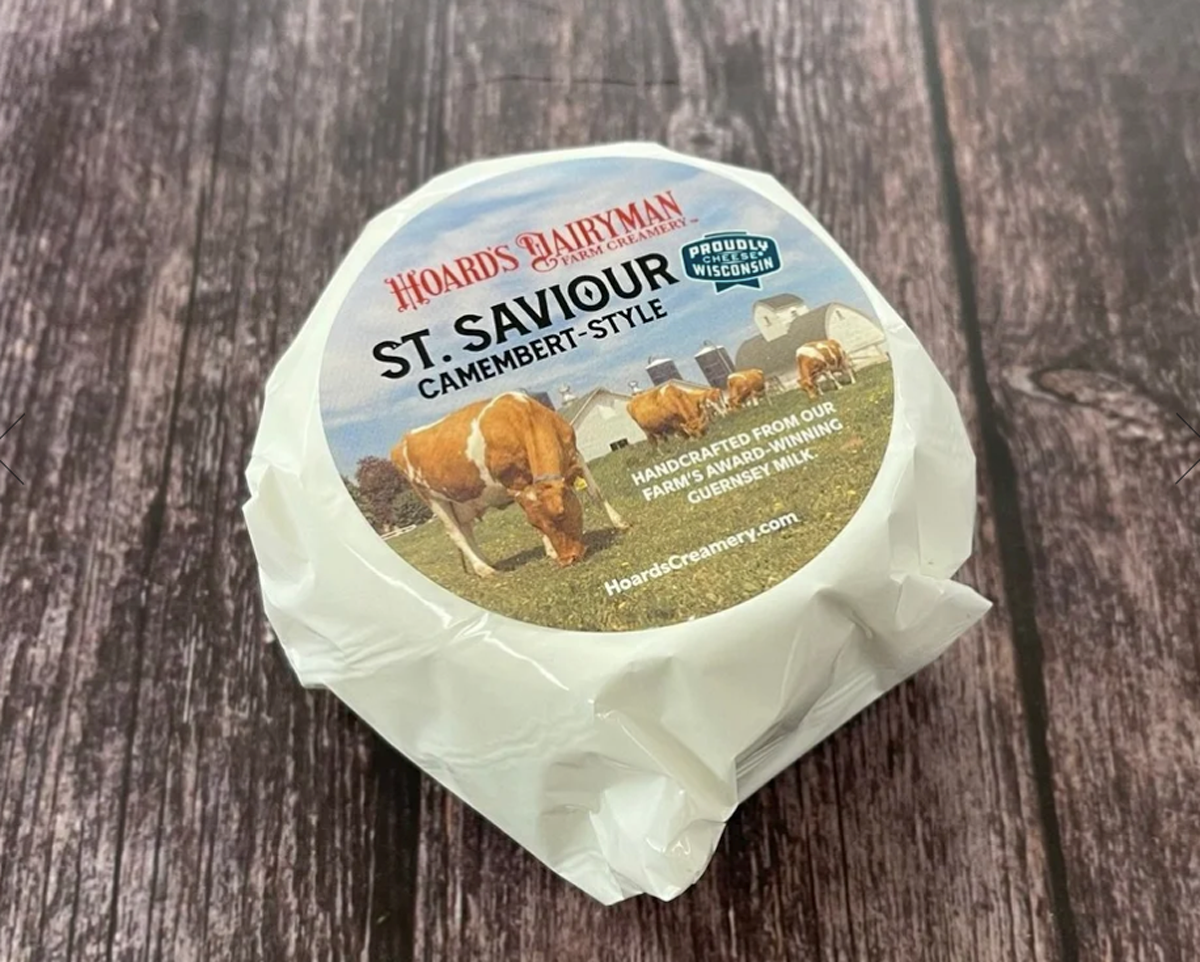What makes Gouda so good?
Some cheeses are acquired tastes and may require fast talking to convince more hesitant palettes to indulge; Bleu and Gorgonzola come to mind. Other cheeses have nearly universal appeal and are safe bets for the lunchbox, dinner table, or charcuterie board.
However, that doesn’t mean these “safe” cheeses are boring. In fact, they’re often anything but. Case in point: Gouda. This Dutch creation has been around since the 1200s — and we think Gouda’s been kept in circulation for good reason. Known for its slightly caramelly, nutty characteristics and its increasing complexity during the aging process, Gouda’s mild but distinctive flavor profile — more sweet than tangy — is achieved during the cheesemaking process. The curds are washed with a hot-water rinse, which removes some of the lactose.
This might sound counterintuitive — lactose is, after all, a sugar — but by taking some of this chemical out of the equation, less lactic acid is produced during the rest of the curds’ journey. The result is a mildly sweet cheese without the characteristic tang of varieties that aren’t treated with this curd-washing method.
Gouda is ready to eat when it’s aged for at least four weeks — at this stage, it’s sweet and mild, with a fudgy texture. Let it age for months or years, and magical things happen: Rich, nutty, and caramel notes unfold, and after a while the cheese will develop its signature crystals and a butterscotch flavor.
Hoard’s Dairyman Farm Creamery Gouda is aged six months — long enough to build character but still remain in the pocket for maximum appeal. We recommend enjoying it with tart apple slices, cured meats, your favorite crackers, and maybe a hearty, whole-grained mustard. Consider a crisp, white wine or a Merlot to complement the spread.
Crazy for Butterkäse? You’re not alone
While social media is currently flooded with people trying a viral food trend: a baked sweet potato stuffed with Butterkäse cheese, we know that the recommended cheese lends itself to much more than this two-ingredient treat. But why does it work so well — and caught on so quickly — in this simple application? Butterkäse has a couple things in its favor here: It melts easily and beautifully, and its mild, creamy flavor offsets the rich, sweet taste of sweet potatoes.
Whether you’re indulging in this cheese for clout or because you love its buttery essence, Butterkäse can be hard to track down. When you do get ahold of some, why not enjoy it with a little more fanfare than just poking it into a potato and calling it good? Here, we take those two ingredients and elevate them to a meal-worthy dish — one that’s perfect for chilly winter nights. Try this sweet potato- Butterkäse gratin and you’ll be racking up “likes” at your own dinner table.
Butterkäse, while it could be swapped out for similar soft and melty cheeses like Bel-Aire or Gouda, really does make the dish here. It’s of German origin and often can even be spread rather than sliced. It’s relatively new to the cheese scene, but it’s universally appealing, with a mild, smooth flavor that sidesteps objections from those who “don’t like cheese.” These days, Germany still produces most of the Butterkäse eaten in Europe, and in the U.S., Wisconsin-based companies — like Hoard’s Dairyman Farm Creamery — offer it locally as well as nationally.
Sweet Potato- Butterkäse Gratin
Ingredients
Five sweet potatoes, average-sized, peeled and sliced about 1/8-inch thick
1 cup whole milk and 1 cup cream or half-and-half
1 small white or yellow onion, sliced thinly
½ teaspoon salt
½ teaspoon freshly ground pepper
½ teaspoon poultry seasoning or combination of sage, rosemary, and thyme
Seven ounces Butterkäse cheese, chopped into small cubes
Fresh parsley, chopped
Preheat oven to 375° F. Mix the milk and cream/half-and-half with the salt, pepper, and seasonings. In a greased two-quart baking dish, or eight individual gratin dishes, layer the milk mixture, sweet potatoes, onion, and cheese, starting with the milk and ending with a sprinkling of cheese cubes. Cover tightly with aluminum foil and baked for 45 minutes. Uncover, garnish with parsley, and bake for about 30 minutes longer, or until the potatoes are fork tender and the liquid has been absorbed. Serves 8 as a side dish — goes great with a mixed leaf salad and a simple roast chicken.
Cheese Feature: Gouda
This 6 month old Gouda will be a welcome addition to your next cheese board and you’ll also find it melts beautifully, opening up endless possibilities for dining and entertaining.
Very few wines will miss when paired with our Gouda, but try a Sauvignon Blanc, Riesling or even your favorite champagne to start. For beer, an ale is a sure bet. Try serving on a cracker with a small wedge of pear or apple. Or slice a baguette and melt your Gouda over thin sliced tomatoes and top with a sliver of capicola or Canadian bacon to experience a little piece of cheese heaven on earth.
Gouda was developed centuries ago in the southern region of the Netherlands and is known for its solid texture and complex character. Young Gouda starts out with an aromatic and sweet, caramel-like flavor that becomes more savory and nutty with age.
Today master cheesemakers are crafting our Gouda from the legendary Guernsey milk that comes exclusively from the Hoard’s Dairyman Farm. Experience the art of cheese in its finest form.
Quiz Time ! ! !
What year were Guernsey dairy cattle recognized as a breed?
a. 1600
b. 1700
c. 1800
d. 1900
If you guessed b. 1700 You are correct!
Quiz Time!
Which country is home to the world’s first cheese factory?
a. England
b. Greece
c. Switzerland
d. Germany
If you answered c. Switzerland you are correct!
Cheese Feature: ST. SAVIOUR: CAMEMBERT-STYLE CHEESE
Named for a small parish on the Isle of Guernsey, our St. Saviour Camembert-style cheese delivers a rich, buttery flavor from a soft, creamy core inside a brilliant rind. Both the core and the rind should be served together for the true St. Saviour experience.
St. Saviour’s versatility will quickly reveal itself. Your favorite baguette or crackers will be transformed. Have some preserves or honey nearby, too. St. Saviour always goes great with apples, pears, and nuts and can take any salad to an entirely new level. Paired with a light red wine, your St. Saviour experience will be one to remember.
Camembert cheese first appeared in Normandy, France in the late 18th century. Today master cheesemakers are crafting our St. Saviour Camembert-style cheese from rich, pure Guernsey milk that comes exclusively from the Hoard’s Dairyman Farm.
Best served at room temperature.
Say cheese: Language and legacy on the Channel Islands
The Channel Islands off the coast of Normandy, France, have a unique and varied history. Residents of the archipelago — whether they’re from the Isle of Guernsey, Jersey, Alderney, or Sark — work to keep their legacies alive via their cultural traditions, their food, and in some cases, even their language. Guernesiais — or Guernsey French — is technically a patois (linguist lingo for a regional dialect) with some estimations of less than 100 fluent speakers, putting it in critically endangered territory. The island of Jersey has Jèrriais (Jersey Norman French), which was officially recognized as a language in 2019. But even though this island stretches less than 11 miles across, its Jèrriais-speaking inhabitants don’t all sound the same, not do they use the same vocabulary. The smaller-still island of Sark, which is just two square miles, also had two distinct variations of Sercquiais, its own dialect.
The BBC offers lessons in Guernsey French, with simple phrases and words available to listen to and practice pronouncing — and with the Channel Island’s rich culinary legacy, you can bet many of these elementary lessons focus on food. The Guernesiais word for cheese appears identical to the modern French term, fromage, but is pronounced slightly differently by the inhabitants of this island who are still fluent in the patois of their ancestors. If you want to give Guernesiais a whirl, the phonetic guide to the following sentence is in parentheses: I'm' faut du fromage. (Eem fow du fromarj.)
The translation? I need cheese. And that’s a sentiment we can get behind, in any language.
Holiday “hygge” — keeping the season cozy, the Danish way
The Danes, according to a few international surveys on the matter, are some of the happiest people in the world. Contributing factors include their community spirit — an attitude which runs parallel to their devotion to family and creating inviting environments. During the holiday season, providing a cozy place to land is paramount no matter your nationality, but we can definitely take a page from the book of the Danish, who specialize in making long, dark winters seem comfortable, homey, and welcoming.
Their word for it is “hygge,” roughly translating to “cozy and contented,” and pronounced “hyoo-guh.” Simple additions to your environment: a candle or two, some textured blankets, warm drinks, and fortifying snacks will heighten the hygge. But for a truly Danish night of hygge (and easy holiday entertaining or meal solutions), look to the tradition of smørrebrød — open-faced sandwiches incorporating a variety of cold cuts, fish, cheese, and toppings.
Start with a good, sturdy rye or sourdough bread (or a combination loaf if you can find one). Crowd-pleasing toppings include sliced cheese — we like Havarti, infused with dill or traditional-style — along with a variety of cold cuts, hard-boiled egg slices, pates, and pickled vegetables. The bread is traditionally spread with butter, but you can get the best of both worldsin one swipe by using a buttery, spreadable cheese like butterkase. Garnish your open-faced sandwiches with fresh dill, red onion, or chives, and present the platter with serve-yourself sauces like remoulade and mustards. A Danish rule of thumb: If you can see the bread through the toppings, you’re not done constructing your hygge holiday masterpiece.
Festive food made easy – elevate your holiday charc boards
Your charcuterie board offerings will be just as delicious if you arrange them simply instead of artfully, but if you’re up for a challenge, the holidays are the perfect time to test your patience and hand-eye coordination. Whether it’s a family movie night or a cocktail party with a few dozen of your closest friends, an impressive display of cheeses, fruits, meats, and starches will have them gathering around the table to sample the selection — and savor your festive style.
A simple way to reflect the holiday theme is to create a charcuterie wreath. You can freestyle itby arranging the goodies directly onto your platter, but we find it easier to use skewers and some sprigs of rosemary, kale leaves, or whatever edible greenery your refrigerator yields. Cube and slice your cheeses first, then prepare the meats, slicing round cuts in the middle and folding or rolling them before threading onto the skewers (see photo). Deal in some colorful and flavorful surprises along the way: fresh or dried fruits, pickled artichoke hearts, cornichons, fresh vegetables, alternating the ingredients along each skewer’s length. As you create the circle, tuck in full-length fresh rosemary sprigs and other greenery to add to the wreath effect. You may want to create some extra skewers ahead of time to replenish!
Charc board choices
Offer a variety of meats, cheeses, and sweet/fruity or briney/savory items, whether you’re creating the skewered wreath or another charc configuration.
A Guernsey good time: La Longue Veille
The eve before Christmas Eve is often filled with holiday activities — even if they’re not officially part of the celebration. Think frantic gift shopping and last-minute menu planning. But on the Island of Guernsey, there is a longstanding December 23rd tradition that has become part of the holiday calendar: La Longue Veille (in both the island’s patois Guernésiais and its parent language, French, it roughly translates to “the long night before”). The occasion is still observed by islanders, who mark it with family and neighborhood gatherings centered around mulled wine (traditionally served in coffee cups or mugs), mild cheeses, and Guernsey biscuits — yeast bread rolls baked using long-established recipes.
La Longue Veille traces its roots back hundreds of years; back in the day, Guernsey residents supported themselves primarily through knitting woolen goods. People of all ages contributed to the trade, men and women alike. In the longer, darker evenings of winter, they’d gather at one house to save on lighting fuel, knitting and singing the nights away. On December 23rd, the year’s projects were gathered and packed up for the Christmas Eve annual fair and market. The work was accompanied by the refreshments that have made the jump to the modern era: Homes that celebrate La Longue Veille still serve the traditional menu, including cheeses made with Guernsey milk, known for its rich flavor and golden hue.
If you’d like to tap into that La Longue Veille magic, choose mild cheeses like our Sark Butterkase, Belaire, and Gouda. For the true Guernsey experience, served mulled wine in mugs and accompany with Guernsey biscuits (recipe below).
Guernsey Biscuits
3 ½ cups flour
4 ½ teaspoons (two packets) active dry yeast
2 teaspoons salt
1 stick unsalted butter, room temperature
1 cup whole milk, warmed to 110° F.
2 teaspoons sugar
Preheat oven to 400° F. Grease a baking sheet; set aside. Sift flour and salt. In a separate bowl, cream the butter and add the sugar and yeast. Add warm milk and let the mixture stand for 10 minutes. Add the flour to the wet mixture and knead thoroughly until incorporated. Let rise in a warm place for an hour and a half; turn out onto a floured surface and punch down. Cut dough with a biscuit cutter and let rounds rise on greased baking sheet for 20 minutes. Bake at 400° for 20 minutes — tops should be golden brown.










